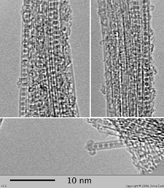Blog-EN
Nanoscale Characterization of Modified Carbon Nanotubes
To reveal the answers to some challenging nanotube science questions, we used two powerful electron microscopy methods, Electron Energy Loss Spectroscopy (EELS) and High Resolution Transmission Electron Microscopy (HR-TEM). We successfully resolved and visualized the structure of some chemically functionalized Carbon Canotubes (CNT).
Three selected systems represents the chemically modified CNT. First are surface thiolated MWCNT, second are 'peapods' made by sucking Dy3N@C80 metallo-fullerenes into SWCNT, forming the Dy3N@C80@SWCNT, third, the conventional C60@SWCNT fullerene peapods, fluorinated by Xenon difluoride (XeF2) up to 18% of F. We also achieved detection of very low amount (less than 0.7%) of sulfur and proven the covalent bonding onto surface MWCNT. As the first worldwide we present EELS imaging of the isolated metal atoms inside endohedral metallofulerene peapods. The last of interesting systems is fluorinated C60 peapods, where we show high degree of homogeneous fluorination across whole surface.
I present the results in the EMRS 2006 poster which is free for download and use, as long as you refer to original source and authors of the work.

